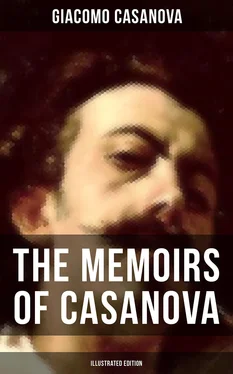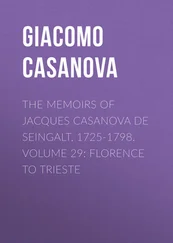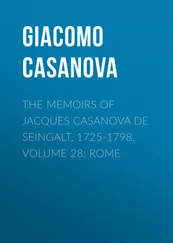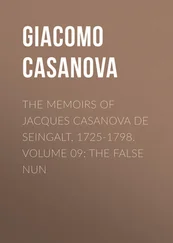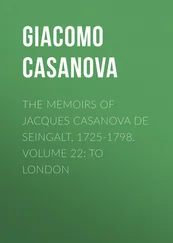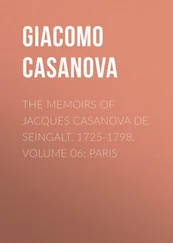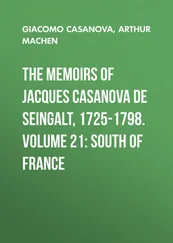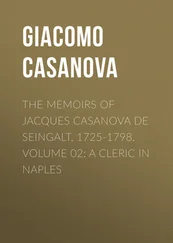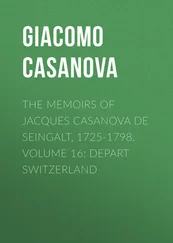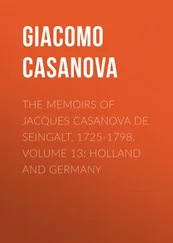Another manuscript which I found tells with great piquancy the whole story of the Abbe de Brosses' ointment, the curing of the Princess de Conti's pimples, and the birth of the Duc de Montpensier, which is told very briefly, and with much less point, in the Memoirs (vol. iii., p. 327). Readers of the Memoirs will remember the duel at Warsaw with Count Branicki in 1766 (vol. X., pp. 274-320), an affair which attracted a good deal of attention at the time, and of which there is an account in a letter from the Abbe Taruffi to the dramatist, Francesco Albergati, dated Warsaw, March 19, 1766, quoted in Ernesto Masi's Life of Albergati, Bologna, 1878. A manuscript at Dux in Casanova's handwriting gives an account of this duel in the third person; it is entitled, 'Description de l'affaire arrivee a Varsovie le 5 Mars, 1766'. D'Ancona, in the Nuova Antologia (vol. lxvii., p. 412), referring to the Abbe Taruffi's account, mentions what he considers to be a slight discrepancy: that Taruffi refers to the danseuse, about whom the duel was fought, as La Casacci, while Casanova refers to her as La Catai. In this manuscript Casanova always refers to her as La Casacci; La Catai is evidently one of M. Laforgue's arbitrary alterations of the text.
In turning over another manuscript, I was caught by the name Charpillon, which every reader of the Memoirs will remember as the name of the harpy by whom Casanova suffered so much in London, in 1763-4. This manuscript begins by saying: 'I have been in London for six months and have been to see them (that is the mother and daughter) in their own house,' where he finds nothing but 'swindlers, who cause all who go there to lose their money in gambling.' This manuscript adds some details to the story told in the ninth and tenth volumes of the Memoirs, and refers to the meeting with the Charpillons four and a half years before, described in Volume V., pages 428-485. It is written in a tone of great indignation. Elsewhere, I found a letter written by Casanova, but not signed, referring to an anonymous letter which he had received in reference to the Charpillons, and ending: 'My handwriting is known.' It was not until the last that I came upon great bundles of letters addressed to Casanova, and so carefully preserved that little scraps of paper, on which postscripts are written, are still in their places. One still sees the seals on the backs of many of the letters, on paper which has slightly yellowed with age, leaving the ink, however, almost always fresh. They come from Venice, Paris, Rome, Prague, Bayreuth, The Hague, Genoa, Fiume, Trieste, etc., and are addressed to as many places, often poste restante. Many are letters from women, some in beautiful handwriting, on thick paper; others on scraps of paper, in painful hands, ill-spelt. A Countess writes pitifully, imploring help; one protests her love, in spite of the 'many chagrins' he has caused her; another asks 'how they are to live together'; another laments that a report has gone about that she is secretly living with him, which may harm his reputation. Some are in French, more in Italian. 'Mon cher Giacometto', writes one woman, in French; 'Carissimo a Amatissimo', writes another, in Italian. These letters from women are in some confusion, and are in need of a good deal of sorting over and rearranging before their full extent can be realised. Thus I found letters in the same handwriting separated by letters in other handwritings; many are unsigned, or signed only by a single initial; many are undated, or dated only with the day of the week or month. There are a great many letters, dating from 1779 to 1786, signed 'Francesca Buschini,' a name which I cannot identify; they are written in Italian, and one of them begins: 'Unico Mio vero Amico' ('my only true friend'). Others are signed 'Virginia B.'; one of these is dated, 'Forli, October 15, 1773.' There is also a 'Theresa B.,' who writes from Genoa. I was at first unable to identify the writer of a whole series of letters in French, very affectionate and intimate letters, usually unsigned, occasionally signed 'B.' She calls herself votre petite amie; or she ends with a half-smiling, half-reproachful 'goodnight, and sleep better than I' In one letter, sent from Paris in 1759, she writes: 'Never believe me, but when I tell you that I love you, and that I shall love you always: In another letter, ill-spelt, as her letters often are, she writes: 'Be assured that evil tongues, vapours, calumny, nothing can change my heart, which is yours entirely, and has no will to change its master.' Now, it seems to me that these letters must be from Manon Baletti, and that they are the letters referred to in the sixth volume of the Memoirs. We read there (page 60) how on Christmas Day, 1759, Casanova receives a letter from Manon in Paris, announcing her marriage with 'M. Blondel, architect to the King, and member of his Academy'; she returns him his letters, and begs him to return hers, or burn them. Instead of doing so he allows Esther to read them, intending to burn them afterwards. Esther begs to be allowed to keep the letters, promising to 'preserve them religiously all her life.' 'These letters,' he says, 'numbered more than two hundred, and the shortest were of four pages: Certainly there are not two hundred of them at Dux, but it seems to me highly probable that Casanova made a final selection from Manon's letters, and that it is these which I have found.
But, however this may be, I was fortunate enough to find the set of letters which I was most anxious to find the letters from Henriette, whose loss every writer on Casanova has lamented. Henriette, it will be remembered, makes her first appearance at Cesena, in the year 1748; after their meeting at Geneva, she reappears, romantically 'a propos', twenty-two years later, at Aix in Provence; and she writes to Casanova proposing 'un commerce epistolaire', asking him what he has done since his escape from prison, and promising to do her best to tell him all that has happened to her during the long interval. After quoting her letter, he adds: 'I replied to her, accepting the correspondence that she offered me, and telling her briefly all my vicissitudes. She related to me in turn, in some forty letters, all the history of her life. If she dies before me, I shall add these letters to these Memoirs; but to-day she is still alive, and always happy, though now old.' It has never been known what became of these letters, and why they were not added to the Memoirs. I have found a great quantity of them, some signed with her married name in full, 'Henriette de Schnetzmann,' and I am inclined to think that she survived Casanova, for one of the letters is dated Bayreuth, 1798, the year of Casanova's death. They are remarkably charming, written with a mixture of piquancy and distinction; and I will quote the characteristic beginning and end of the last letter I was able to find. It begins: 'No, it is impossible to be sulky with you!' and ends: 'If I become vicious, it is you, my Mentor, who make me so, and I cast my sins upon you. Even if I were damned I should still be your most devoted friend, Henriette de Schnetzmann.' Casanova was twenty-three when he met Henriette; now, herself an old woman, she writes to him when he is seventy-three, as if the fifty years that had passed were blotted out in the faithful affection of her memory. How many more discreet and less changing lovers have had the quality of constancy in change, to which this life-long correspondence bears witness? Does it not suggest a view of Casanova not quite the view of all the world? To me it shows the real man, who perhaps of all others best understood what Shelley meant when he said:
True love in this differs from gold or clay
That to divide is not to take away.
But, though the letters from women naturally interested me the most, they were only a certain proportion of the great mass of correspondence which I turned over. There were letters from Carlo Angiolini, who was afterwards to bring the manuscript of the Memoirs to Brockhaus; from Balbi, the monk with whom Casanova escaped from the Piombi; from the Marquis Albergati, playwright, actor, and eccentric, of whom there is some account in the Memoirs; from the Marquis Mosca, 'a distinguished man of letters whom I was anxious to see,' Casanova tells us in the same volume in which he describes his visit to the Moscas at Pesaro; from Zulian, brother of the Duchess of Fiano; from Richard Lorrain, 'bel homme, ayant de l'esprit, le ton et le gout de la bonne societe', who came to settle at Gorizia in 1773, while Casanova was there; from the Procurator Morosini, whom he speaks of in the Memoirs as his 'protector,' and as one of those through whom he obtained permission to return to Venice. His other 'protector,' the 'avogador' Zaguri, had, says Casanova, 'since the affair of the Marquis Albergati, carried on a most interesting correspondence with me'; and in fact I found a bundle of no less than a hundred and thirty-eight letters from him, dating from 1784 to 1798. Another bundle contains one hundred and seventy-two letters from Count Lamberg. In the Memoirs Casanova says, referring to his visit to Augsburg at the end of 1761:
Читать дальше
